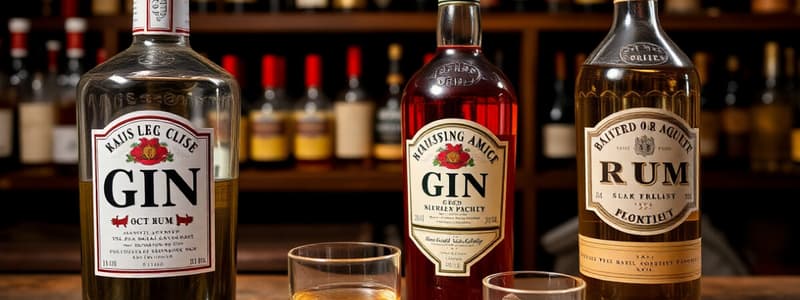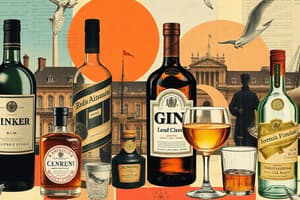Podcast
Questions and Answers
What was a major consequence of the introduction of large tariffs on French brandy and wine by King William III?
What was a major consequence of the introduction of large tariffs on French brandy and wine by King William III?
- Increased popularity of rum in England
- A rise in the consumption of gin (correct)
- The decline of local distilleries
- Stricter regulations on beer production
What was the primary reason for the establishment of the Gin Act of 1751?
What was the primary reason for the establishment of the Gin Act of 1751?
- To increase gin's market popularity
- To control the rampant abuse of gin (correct)
- To promote gin production overseas
- To eliminate British distillery competition
How did the introduction of quinine water affect the popularity of gin in the 1800s?
How did the introduction of quinine water affect the popularity of gin in the 1800s?
- It contributed to gin's revival as a popular drink (correct)
- It reduced the alcohol content in gin
- It led to the prohibition of gin-based drinks
- It made gin less desirable due to its bad taste
Which of the following motivated King William III to promote gin production in England?
Which of the following motivated King William III to promote gin production in England?
What effect did the Gin Craze have on individuals depicted in lithographs from that period?
What effect did the Gin Craze have on individuals depicted in lithographs from that period?
What was the relationship between gin and beer during the Gin Craze?
What was the relationship between gin and beer during the Gin Craze?
What traditional purpose did juniper berries and herbs serve before the distillation of spirits?
What traditional purpose did juniper berries and herbs serve before the distillation of spirits?
Which drink gained popularity in the 1800s as a result of mixing gin with quinine water?
Which drink gained popularity in the 1800s as a result of mixing gin with quinine water?
What led to the increase in the importation of African slaves in the Caribbean?
What led to the increase in the importation of African slaves in the Caribbean?
Which political event influenced the change in Bacardi's operations during the 1950s?
Which political event influenced the change in Bacardi's operations during the 1950s?
What was a primary argument for the prohibition movement in Canada?
What was a primary argument for the prohibition movement in Canada?
What impact did World War I have on prohibition in Canada?
What impact did World War I have on prohibition in Canada?
Which group was notably opposed to prohibition in Quebec?
Which group was notably opposed to prohibition in Quebec?
The introduction of prohibition in Canada was largely influenced by which movement?
The introduction of prohibition in Canada was largely influenced by which movement?
What was the significance of the rum ration given to British Navy sailors?
What was the significance of the rum ration given to British Navy sailors?
What major change occurred in the Bacardi distillery after the Cuban Revolution?
What major change occurred in the Bacardi distillery after the Cuban Revolution?
What was one of the primary reasons for the establishment of the Woman's Christian Temperance Union (WCTU)?
What was one of the primary reasons for the establishment of the Woman's Christian Temperance Union (WCTU)?
Which statement accurately reflects the results of the 1896 referendum on prohibition in Canada?
Which statement accurately reflects the results of the 1896 referendum on prohibition in Canada?
The phrase 'Demon rum' in the context of World War I refers to what?
The phrase 'Demon rum' in the context of World War I refers to what?
What was a notable outcome of the prohibition era in terms of enforcement?
What was a notable outcome of the prohibition era in terms of enforcement?
What impact did rum culture have on American military identity during World War I?
What impact did rum culture have on American military identity during World War I?
What motivated American producers to shift from rum to whisky?
What motivated American producers to shift from rum to whisky?
What was the primary economic effect of prohibition on the alcohol industry?
What was the primary economic effect of prohibition on the alcohol industry?
What solution did Ontario implement after ending prohibition?
What solution did Ontario implement after ending prohibition?
Which major event occurred in 1933 regarding alcohol in the United States?
Which major event occurred in 1933 regarding alcohol in the United States?
What was a consequence of the rise of a black market during prohibition?
What was a consequence of the rise of a black market during prohibition?
What does the Liquor Control Act aim to promote according to Howard Ferguson?
What does the Liquor Control Act aim to promote according to Howard Ferguson?
What were the major levels of control faced by multinationals in alcohol marketing?
What were the major levels of control faced by multinationals in alcohol marketing?
How did the merger of InBev and AB Anheuser influence the global beer market?
How did the merger of InBev and AB Anheuser influence the global beer market?
What was a significant limitation of voluntary codes of conduct in alcohol advertising?
What was a significant limitation of voluntary codes of conduct in alcohol advertising?
What health warning must be included in alcohol advertisements according to regulations?
What health warning must be included in alcohol advertisements according to regulations?
What aspect of alcohol marketing is particularly restricted in France under the Loi Evin?
What aspect of alcohol marketing is particularly restricted in France under the Loi Evin?
What was one outcome of Ontario's decision to create a government monopoly on alcohol distribution?
What was one outcome of Ontario's decision to create a government monopoly on alcohol distribution?
What challenge do smaller jurisdictions face in implementing alcohol regulation?
What challenge do smaller jurisdictions face in implementing alcohol regulation?
Which of the following describes the essence of marketing strategies used by major alcohol companies?
Which of the following describes the essence of marketing strategies used by major alcohol companies?
What was the effect of prohibition on personal fortunes of brewers?
What was the effect of prohibition on personal fortunes of brewers?
Flashcards
Gin Craze (1700s)
Gin Craze (1700s)
A period in England where gin became extremely popular, inexpensive, and frequently abused, leading to social problems and government intervention.
Gin's Impact on England
Gin's Impact on England
Gin's popularity in England was tied to economic and political conditions, leading to high levels of consumption and social issues relating to excessive drinking
Early Gin Production
Early Gin Production
The Dutch developed Gin, combining wine, alcohol and herbs (in the 1700s), gaining popularity due to low production cost and palatability.
Impact of Gin Act 1751
Impact of Gin Act 1751
Signup and view all the flashcards
Gin and Tonic
Gin and Tonic
Signup and view all the flashcards
Rum's Political Influence
Rum's Political Influence
Signup and view all the flashcards
Alcohol's Historical Role
Alcohol's Historical Role
Signup and view all the flashcards
Trade Policy's Unintended Consequences
Trade Policy's Unintended Consequences
Signup and view all the flashcards
Rum's Colonial Roots
Rum's Colonial Roots
Signup and view all the flashcards
Rum Ration in the Navy
Rum Ration in the Navy
Signup and view all the flashcards
Bacardi's Rise
Bacardi's Rise
Signup and view all the flashcards
Prohibition
Prohibition
Signup and view all the flashcards
Prohibition's Motivation
Prohibition's Motivation
Signup and view all the flashcards
Canadian Prohibition Debate
Canadian Prohibition Debate
Signup and view all the flashcards
WW1 Prohibition
WW1 Prohibition
Signup and view all the flashcards
Rum as Morale Booster
Rum as Morale Booster
Signup and view all the flashcards
Post-WW1 Prohibition Concerns
Post-WW1 Prohibition Concerns
Signup and view all the flashcards
Prohibition's Social Impact
Prohibition's Social Impact
Signup and view all the flashcards
Bootlegging
Bootlegging
Signup and view all the flashcards
US 18th Amendment
US 18th Amendment
Signup and view all the flashcards
Cuba Libre and Revolution
Cuba Libre and Revolution
Signup and view all the flashcards
Prohibition's Negative Effects
Prohibition's Negative Effects
Signup and view all the flashcards
Wilfred Laurier & Referendum
Wilfred Laurier & Referendum
Signup and view all the flashcards
Prohibition's Economic Impact
Prohibition's Economic Impact
Signup and view all the flashcards
Prohibition's Unexpected Outcome
Prohibition's Unexpected Outcome
Signup and view all the flashcards
Government Control of Alcohol
Government Control of Alcohol
Signup and view all the flashcards
LCBO's Evolution
LCBO's Evolution
Signup and view all the flashcards
Dominance of Multinational Alcohol Companies
Dominance of Multinational Alcohol Companies
Signup and view all the flashcards
Alcohol Marketing: Tension between Health and Profit
Alcohol Marketing: Tension between Health and Profit
Signup and view all the flashcards
Voluntary Codes of Conduct for Alcohol Advertising
Voluntary Codes of Conduct for Alcohol Advertising
Signup and view all the flashcards
Regulatory Restrictions for Alcohol Advertising
Regulatory Restrictions for Alcohol Advertising
Signup and view all the flashcards
Loi Evin: France's Alcohol Marketing Regulation
Loi Evin: France's Alcohol Marketing Regulation
Signup and view all the flashcards
Effectiveness of Alcohol Advertising Regulation
Effectiveness of Alcohol Advertising Regulation
Signup and view all the flashcards
Multinationals and Alcohol Regulation: Challenges
Multinationals and Alcohol Regulation: Challenges
Signup and view all the flashcards
Balancing Profits and Health: The Alcohol Industry's Dilemma
Balancing Profits and Health: The Alcohol Industry's Dilemma
Signup and view all the flashcards
Alcohol's Societal Impact: A Complex Issue
Alcohol's Societal Impact: A Complex Issue
Signup and view all the flashcards
The Role of Heritage Brands in the Alcohol Industry
The Role of Heritage Brands in the Alcohol Industry
Signup and view all the flashcards
Study Notes
The Business of Alcohol
- Alcohol has a long history intertwined with trade, politics, and societal impact, with practices varying across civilizations.
- Policies surrounding spirits often have unintended consequences.
Gin Craze
- Gin, a distilled spirit, gained popularity in 17th-century England.
- Its affordability and high rates of consumption led to social issues and government intervention (Gin Act of 1751).
- The drink's popularity revived in the 1800s, often mixed with quinine, leading to the Gin and Tonic.
Rum's History
- Rum, a byproduct of sugar production in colonies, became popular in the 1700s, tied to slave trade.
- Rum consumption was influential in Colonial and political systems, with British Navy rations and American colonies vying for control.
- Cuba's rum industry became prominent under Spanish rule and afterward, with its company (Bacardi) adjusting to political changes and establishing a global presence.
- Castro's revolution nationalized distilleries, causing Bacardi to relocate and adapt to the changing global market.
Prohibition
- Prohibition, the act of forbidding alcohol, was prevalent in 19th and early 20th-century North America.
- Driven by moral and economic concerns, with women's rights movement involvement.
- Canada experimented with prohibition, facing complex opinions and close referendums on the matter .
- WWI had an influence on prohibition movements and their impact on soldiers overseas.
- Post-war, the success of prohibition was questioned.
Prohibition's Economic Impact
- Prohibition resulted in the creation of a black market and criminal activity.
- Reduced economic activity in the brewing and distilling industries.
- Led to widespread economic displacement and a rise in organized crime.
The Evolution of Alcohol Control and Legislation
- Ontario introduced government control over alcohol distribution.
- Over time, laws surrounding alcohol became progressively less strict, leading to greater personal liberty & commerce
- Following prohibition, the LCBO reformed to manage alcohol sales in Canada
Marketing Strategies
- A small number of multinational enterprises controls the global alcohol market (e.g., AB InBev).
- Heritage brands and familiarity have played a significant role in their success.
- There is ongoing tension between profit and public concern regarding alcohol consumption.
- Government controls on alcohol advertising vary from voluntary codes of conduct to strict regulatory restrictions (e.g., Loi Evin in France).
Studying That Suits You
Use AI to generate personalized quizzes and flashcards to suit your learning preferences.




